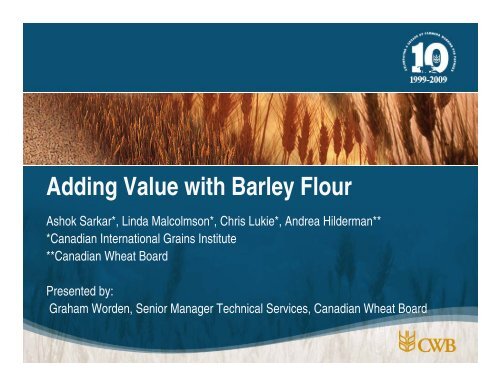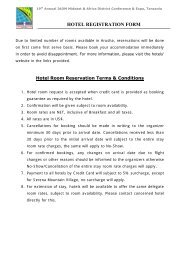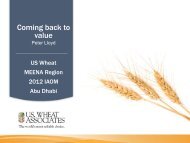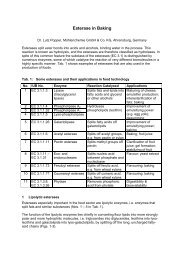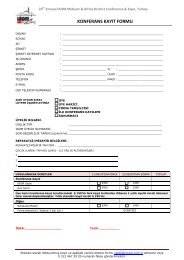Technical Session - Tech #6 Adding Value with Barley Flour
Technical Session - Tech #6 Adding Value with Barley Flour
Technical Session - Tech #6 Adding Value with Barley Flour
Create successful ePaper yourself
Turn your PDF publications into a flip-book with our unique Google optimized e-Paper software.
<strong>Adding</strong> <strong>Value</strong> <strong>with</strong> <strong>Barley</strong> <strong>Flour</strong><br />
Ashok Sarkar*, Linda Malcolmson*, l Chris Lukie*, Andrea Hilderman**<br />
*Canadian International Grains Institute<br />
**Canadian Wheat Board<br />
Presented by:<br />
Graham Worden, Senior Manager <strong><strong>Tech</strong>nical</strong> Services, Canadian Wheat Board
The Beginning...<br />
2
... The Accepted...<br />
4
Traditional Food <strong>Barley</strong> Products<br />
• Malted barley<br />
• <strong>Barley</strong> flakes, grits, and flours<br />
• Pot and pearled <strong>Barley</strong><br />
• <strong>Barley</strong> tea<br />
• Shochu<br />
• Tsampaa<br />
• etc<br />
5
... Hulless barley...<br />
6
... The Food<br />
7
Categories of barley from western Canada<br />
Two types of<br />
<strong>Barley</strong><br />
Hulled, e.g.<br />
Metcalfe,Legacy<br />
Hulless<br />
“Food <strong>Barley</strong>”<br />
Starch<br />
Composition<br />
High Amylose<br />
none registered<br />
in Canada<br />
~40% amylose<br />
~7% β-glucan<br />
Waxy<br />
e.g. Fibar, Rattan<br />
0-5% amylose<br />
6-10+% β-glucan<br />
Regular Starch<br />
e.g. Falcon,<br />
McGwire<br />
~25% amylose<br />
~4% β-glucan<br />
8
What is Whole Grain?<br />
Whole grains, or foods made from them, contain all the<br />
essential parts and naturally-occurring nutrients of the<br />
entire grain seed. If the grain has been processed (e.g.,<br />
cracked, crushed, rolled, extruded, d and/or cooked), the<br />
food product should deliver approximately the same rich<br />
balance of nutrients that are found in the original i grain<br />
seed.<br />
Whole Grains Council, May 2004,<br />
www.wholegrainscouncil.org/<br />
9
Carbohydrates:<br />
Starch (58-64%)<br />
NSP (9-16%)<br />
• β-glucan (3-9%)<br />
• Arabinoxylan (3-9%)<br />
Micronutrients:<br />
Vitamins, Minerals,<br />
Antioxidants (phenolic<br />
acids, lignans)<br />
Whole Grain <strong>Barley</strong><br />
Lipids (2-3%) Protein (8-15%)<br />
10
Comparison of Nutritional Attributes of<br />
Whole Grain <strong>Flour</strong>s<br />
Nutrients WG Wheat 1 WG <strong>Barley</strong> 2<br />
Calories, kcal 339 345<br />
1<br />
Carbohydrates, % 72.6 73.5<br />
Soluble dietary fiber, % 0.5 4.6<br />
Ttldit Total dietary fiber, % 12.22 12.7<br />
Protein, % 13.7 12.2<br />
Source: 1 Canadian Nutrient File; 2 CIGI Analytical Services<br />
11
The Opportunity- Health Claim<br />
• In May 2006 the US Dept of Agriculture (USDA) approved a barley<br />
health claim<br />
• Manufacturers can make a health claim provided the food contains<br />
at least 0.75 grams of soluble fibre (β-glucan) per serving<br />
• This recognition of barley nutritive value is resulting in increased<br />
interest in barley as an ingredient<br />
Health Claim:<br />
“Soluble fibre from food, such as (Whole Grain <strong>Barley</strong> Bagel), as<br />
part of a diet low in saturated fat and cholesterol, may reduce the<br />
risk of heart disease. A serving of (one 95 g bagel) supplies (0.79)<br />
grams of the soluble fiber necessary per day to have this effect.”<br />
12
Health Benefits Associated <strong>with</strong> Whole Grains and <strong>Barley</strong><br />
Soluble Fibre<br />
• Type 2 diabetes risk reduced 21 - 30%<br />
• Stroke risk reduced 30 - 36%<br />
• Heart disease risk reduced 25 - 28%<br />
• Reduces risk of cancer<br />
• Healthier carotid arteries<br />
• Reduction of inflammatory disease risk<br />
• Can play a role in weight management<br />
• Low glycemic index (GI)<br />
Source: www.wholegrainscouncil.org/<br />
13
<strong>Barley</strong> has it all<br />
• Source of both soluble and<br />
insoluble dietary fiber<br />
• High in β-glucan soluble fiber<br />
• High in antioxidants<br />
• Adapts to many growing g<br />
environments<br />
14
Comparison of Biochemistry of Whole<br />
Grain <strong>Barley</strong> <strong>Flour</strong> varieties<br />
Variety<br />
Starch Type β-glucan (%) Total Fibre (%) Protein (%)<br />
(amyloseamylopectin<br />
ratio)<br />
McGwire Normal 43 4.3 12.7 10.6<br />
Falcon Normal 3.7 11.9 12.2<br />
Millhouse Normal 4.1 9.8 12.6<br />
CDC Rattan 95% Waxy 5.5 12.0 12.0<br />
CDC Fibar 100% Waxy 7.5 16.3 13.9<br />
15
Functionality of barley in foods:<br />
POSITIVES<br />
• Increased water absorption<br />
• Increased water retention ti in baked goods (improves<br />
density, texture, and volume)<br />
• Increased product yield<br />
• Nutty, wholesome flavour<br />
• Standard processing equipment<br />
• Increasing levels of research in food barley applications<br />
16
Functionality of barley in foods:<br />
NEGATIVES<br />
• <strong>Barley</strong> lacks functional gluten proteins<br />
• Supply of food barley is limited at this time<br />
• Extent of knowledge of barley as a food is low<br />
• Message is slow to be accepted<br />
17
Absorption and moisture content comparison for bagels of varying levels of barley flour<br />
Moisture<br />
(%)<br />
70<br />
60<br />
50<br />
40<br />
30<br />
Absorption Moisture<br />
60<br />
58<br />
53 54 55<br />
33 34<br />
32 33 33<br />
20<br />
0 5 15 30 40<br />
Whole Grain CDC McGwire <strong>Barley</strong> <strong>Flour</strong> (%)<br />
18
Absorption and moisture content of baked goods <strong>with</strong> different whole grain barley flours<br />
80<br />
70<br />
68<br />
73<br />
75<br />
Absorption<br />
Moisture<br />
64 64<br />
73<br />
Moist ure(%)<br />
60<br />
50<br />
40<br />
30<br />
39 40 40<br />
54<br />
56<br />
31 31<br />
34<br />
55<br />
31 30<br />
32<br />
20<br />
Control<br />
CDC<br />
CDC<br />
Control<br />
CDC<br />
CDC<br />
Control<br />
CDC<br />
CDC<br />
McGwire Fibar<br />
McGwire Fibar<br />
McGwire Fibar<br />
30% <strong>Barley</strong> Bread 30% <strong>Barley</strong> Bagel 50% <strong>Barley</strong> Tortilla<br />
19
Nutritional Information<br />
25% Whole Grain <strong>Barley</strong> Pasta<br />
Per Serving<br />
• 85 g<br />
• 19 g whole grains<br />
• 5 g TDF<br />
• 1 g soluble fibre<br />
20
Nutritional Information<br />
30% Whole Grain <strong>Barley</strong> Bagel<br />
Per Serving<br />
• One bagel, 95 g<br />
• 17 g whole grains<br />
• 3 g TDF<br />
• 1 g soluble fibre<br />
21
Nutritional Information<br />
30% Whole Grain <strong>Barley</strong> Bread<br />
Per Serving<br />
• 2 slices, 75 g<br />
• 12 g whole grains<br />
• 2 g TDF<br />
• 0.5 g soluble fibre<br />
22
40% WG <strong>Barley</strong> Sourdough Artisan Bread<br />
23
Nutritional Information<br />
50% Whole Grain <strong>Barley</strong> Tortilla<br />
Per Serving<br />
• One tortilla, 60 g<br />
• 20 g whole grains<br />
• 3 g TDF<br />
• 1 g soluble fibre<br />
24
Nutritional Information<br />
50% Whole Grain <strong>Barley</strong> Pita<br />
Per Serving<br />
• One pita, 60 g<br />
• 19 g whole grains<br />
• 3 g TDF<br />
• 1 g soluble fibre<br />
25
Nutritional Information<br />
100% Whole Grain <strong>Barley</strong> Cereal<br />
Per Serving<br />
• 1 cup, 30 g<br />
• 28 g whole grains<br />
• 3.5 g TDF<br />
• 1.2 g β-glucan soluble fibre<br />
• 3 g protein<br />
26
Commercial Products<br />
27
So……..<br />
• Whole Grain <strong>Barley</strong> flour is a nutritionally advanced<br />
product that is a good answer to increasing healthy food<br />
in the diet<br />
• <strong>Barley</strong> is still at an early stage of acceptance as a food<br />
ingredient<br />
• <strong>Barley</strong> flour can be added into many products and is a<br />
sensible addition based on nutrition<br />
• <strong>Barley</strong> flour is easy to produce and provides functional<br />
benefits when added to food products<br />
28
<strong>Barley</strong> as a healthy ingredient – milling technology<br />
• <strong>Barley</strong> can be easily milled and incorporated into foods<br />
such as breads, pasta, noodles and breakfast cereals at<br />
relatively high inclusion rates<br />
• <strong>Barley</strong> can be successfully milled on conventional wheat<br />
milling equipment<br />
29
Hulled barley preparation<br />
Size<br />
reduction<br />
Cleaning Pearling Milling<br />
30
Cleaning<br />
• Disc separators or indented cylinders require attention to<br />
ensure proper separation or loss<br />
• Hulls are completely removed and aspirated away through<br />
the scourer<br />
• Utilize a color sorter in the flow to remove any discolored<br />
kernels<br />
31
Kernel hardness and tempering<br />
Varieties Type Amylose<br />
%<br />
Millhouse,<br />
CDC McGwire<br />
CDC Candle,<br />
CDC Rattan<br />
Regular<br />
(normal<br />
starch)<br />
Low amylose<br />
(waxy)<br />
β-glucan<br />
%<br />
Kernel<br />
hardness<br />
20.0 – 30.0 4.0-5.0 Hard<br />
Hulless <strong>Barley</strong><br />
Hulless Waxy<br />
<strong>Barley</strong><br />
Hulled barley<br />
33
Comparative steps in milling wheat & barley<br />
System Wheat flour milling <strong>Barley</strong> flour milling<br />
Break passages 4 4<br />
Reduction passages 8 4<br />
Purification passages 2 1<br />
(used only as a carrier)<br />
Bran duster 1 1<br />
Shorts duster 1 1<br />
34
Additional process changes & results expected<br />
from milling wheat & barley<br />
System<br />
Wheat flour<br />
milling<br />
Hulless barley flour milling<br />
Regular<br />
starch<br />
Throughput, % 100 75 60<br />
Waxy starch<br />
<strong>Flour</strong> screens, 9 N – 13 N 100 W 60 W – 100 W<br />
nylons (N) or wire (W)<br />
Expected flour yield,<br />
%<br />
Expected flour<br />
granulations<br />
74 - 76 71 - 75 63 – 67<br />
99%
1 BK<br />
<strong>Barley</strong> milling – flow diagram<br />
P<br />
2Q<br />
2 BK<br />
P<br />
2 x 28 W<br />
3 x 40 W<br />
4 x 100 W<br />
2 x 8 N<br />
3BK<br />
FLOUR<br />
2 M MMM<br />
2 M2 M<br />
M M MMM<br />
1M<br />
40 38 36 34<br />
44 42 38 36<br />
50 46 42 38<br />
B D<br />
2 BK SIFTER<br />
4 BK<br />
2Q<br />
2Q<br />
5M<br />
5M<br />
2 x 18 W<br />
2x90W<br />
3 x 12 N<br />
2 x 12 N<br />
2 x 50 W<br />
GERM GGERM<br />
T<br />
FLOUR<br />
MF<br />
3 BK<br />
P<br />
3 x 45 W<br />
4 x100 W<br />
2 x 100 W<br />
2 x 8.5 N<br />
4 BK<br />
FLOUR<br />
2 M<br />
0.60<br />
T<br />
0.75<br />
S D<br />
BRAN<br />
SHORTS<br />
T<br />
LG<br />
5M<br />
1 x 80 W<br />
1 X 90 W<br />
3 x 8.5 N<br />
2 x 45 W<br />
2 x 90 W<br />
4 x 100 W<br />
FLOUR<br />
MF<br />
FLOUR<br />
4 BK<br />
2 x 26 W<br />
1 x 40 W<br />
2 x 45/50<br />
B D<br />
S D<br />
T<br />
LG<br />
1x90W<br />
T<br />
2 x100W<br />
4 x100W<br />
FLOUR<br />
5 M<br />
2 x 50 W<br />
1 x 60 W<br />
MF<br />
4 x 100 W<br />
1 X 10N<br />
FLOUR<br />
36<br />
T


